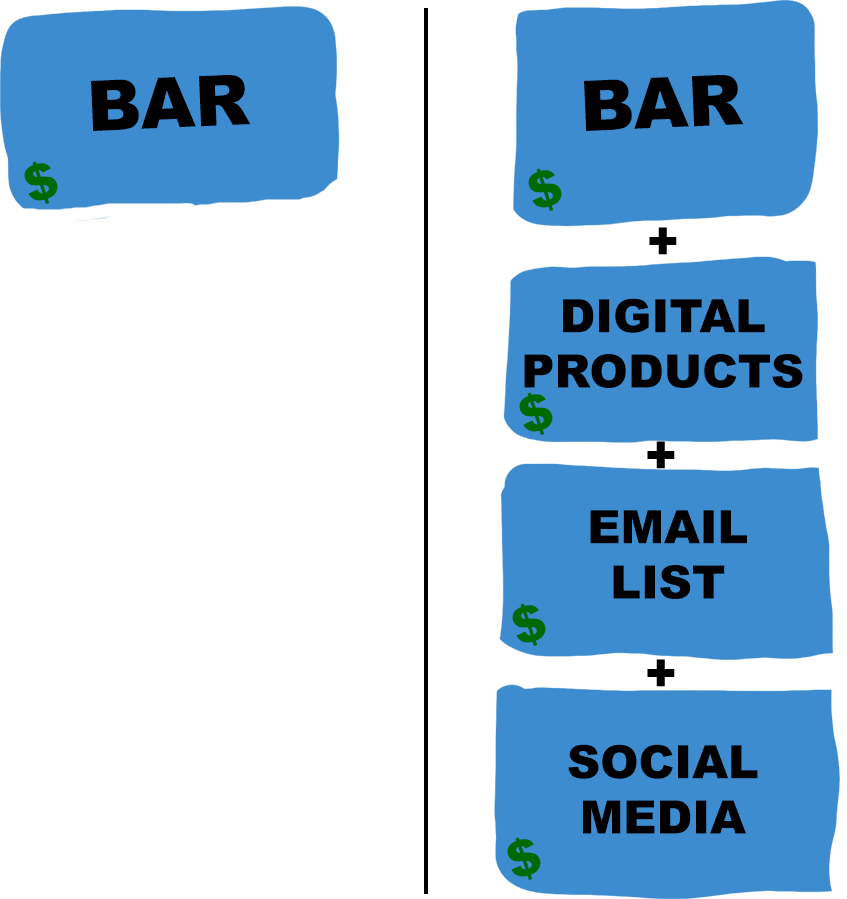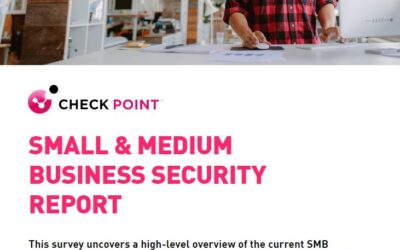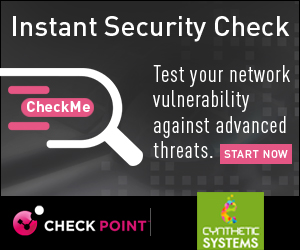(Kyle added a “Digital Bartending School” to his physical bar)
A simple digital product got this bar an extra $49,000, plus moved them into a Physical + Digital hybrid.
Bars and restaurants are generally understood to be low margin businesses with few revenue streams.
But they don’t need to be.
For example, we built a “digital bartending school” that made Kyle $49,000+ in addition to what they were already making.
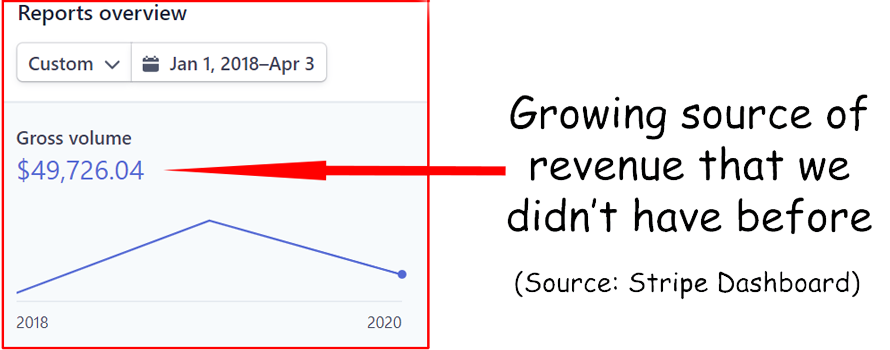
(We also accept cash, PayPal, and barter, so this is just part of the story).
Is this a crazy “6-figure” business? No, but if you’re a bar or restaurant that’s operating with razor thin margins, this is found money that will give you some extra padding.
Here’s why an educational experience made sense…
It’s low-impact:
Our school runs Saturdays and Sundays for 1.5 – 2 hours for 6 weekends, and our expenses range from $300-$500 CAD per course depending on the number of students in the class. This covers instructors and product usage.
It maximizes the use of the space:
We run our school out of a bar that’s closed during the day. There are TONS of bars and restaurants that are closed during the day you could use, too.
It builds a virtuous cycle:
Students are super engaged so they come visit their instructors as customers during opening hours so that they can keep learning. We also encourage them to visit other bars.
It gives your team a way to shine:
Bars and restaurants are HOTBEDS of talent and nothing makes these folks happier than to share what they know.
It’s a great way to build community:
A rising tide lifts all ships.
It forces you to document your training process:
Creating a school forced us to document training procedures, gave us a very impressive way to train new bartenders, and vet possible hires for later.
It becomes the basis of a consulting arm:
Which leads to more ‘found’ money.
Now let’s show you how we did it.
Step 1: We wrote a simple sales page in Google Docs.
We wanted to create more revenue for the business, but they weren’t sure where to start.
At first, we figured we’d bring cocktails to off-site locations like events, parties, bachelorettes, whatever. We would do cocktail catering for anyone with a pulse.
But we quickly realized— too many logistics and they weren’t charging enough to make it worth it.
They wanted to build something simple, repeatable, and high-impact!
The owner started noticing that all of the companies he admired most had these behemoth pages that he couldn’t help but devour, and, eventually, buy from.
Many of these companies were in marketing, tech, finance — none of them were restaurants, so at first he figured that there was no place for these huge-ass pages for hospitality folk.
Then one day he said screw it, let’s try it.
He reached out to Cynthetic Systems and had a virtual roundtable discussion and quickly discovered they’re actually not that hard when you use a model.
We started by answering the following questions…
- Who’s it for?
- What is it?
- What’s the time commitment?
- What will they learn?
- What do they get?
- How much is it?
- What promise / guarantee can I make?
- What proof do I have? (more on that in a bit)
Once he answered those questions in writing, we could use that copy for the sale page.
ACTION TIP: Create a digital place for your audience to show up, engage, and maybe buy something from you. A sales page or landing page is a great way to test new income ideas and build marketing assets like an email list.
Step 2: We built a sales page with easy-to-use tools
There are many straightforward tools designed just for building landing and sales pages. When I got started, we finally settled on the Divi plugin for WordPress. And build our own ClickFunnel.
Why? It’s mostly a matter of cutting expenses, and Divi is easier to use than the competitors.
Here are a couple screenshots we dug up from early days building the sales page in WordPress.
Our Cynthetic Systems developer was able replicate it on our website. The $100-$200 you’ll pay Cynthetic will quickly pay for itself.
ACTION TIP: Choose Cynthetic to help with creative, technology and publishing your page.
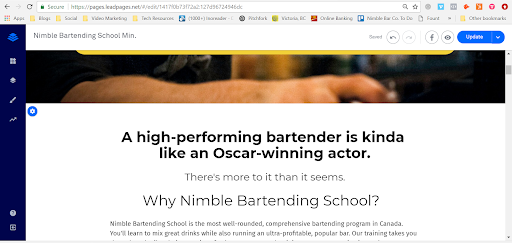

Step 3: We collected “proof”, like testimonials, reviews, and customer photos.
The biggest challenge we had in selling a school that didn’t exist was proof.
When it comes down to it, that’s what marketing is — proving you can transform someone.
Here are some examples of proof that we could add to the sales page:
We hired great instructors and asked their colleagues how they’ve helped them learn / grow — turned those into testimonials.
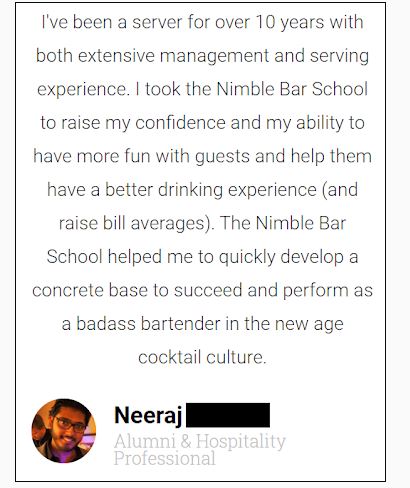
When Neeraj wrote a review for us, he was actually talking about one of the instructors we brought on board. We just flipped the instructor’s name for the school, checked that that was okay with him, and voila, we had a testimonial!
He eventually took the course and confirmed that it was all true 🙂
We reached out to brands we worked with through the restaurant and asked if they would support our program:

Then we added a simple logo banner to bolster our credibility.
Here’s a video where we give a look under-the-hood. It’s professionally-shot and it highlights the skills as a bartender and an instructor.
We hired a photographer for the first class:
Having a photographer around was a good move so we could capture all the learning and fun (and use the photos on the sales page):
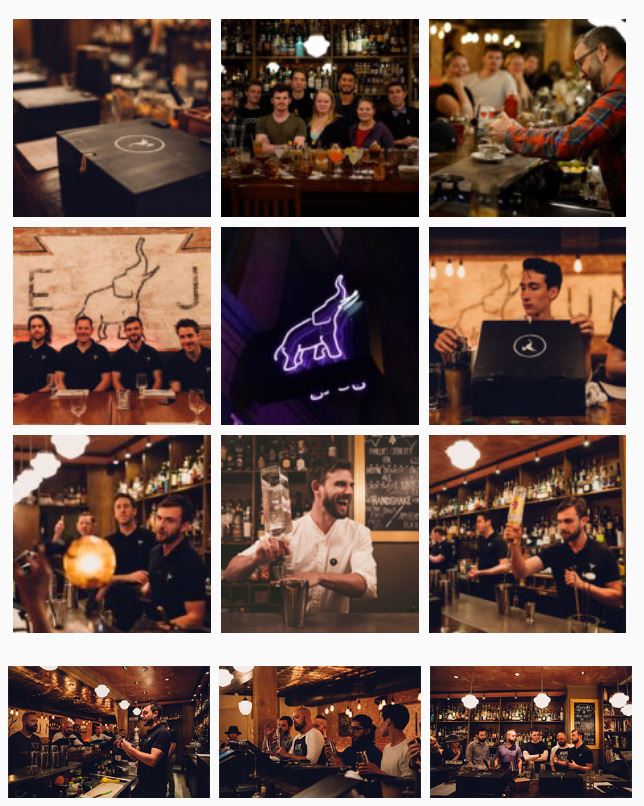
We still use many of these shots today — well worth the $300.00 investment in a photographer for our first class.
Looking back, I would have taken photos earlier. These end up being the best social proof. Get some friends and regulars at your bar, have a bartender teach them how to make a cocktail or two, and snap some shots!
We created surveys and asked students for testimonials as soon as possible:
If you aim to have a big impact on students right from the get-go, you don’t need to wait until the end of the 6 weekend experience to get a testimonial. You can send them a survey after 1 or 2 classes and get testimonials right away.
Ask what they’re enjoying, what they’d like more of, and if they’d recommend the course to a friend. If so, what would they say to their friends?
People sometimes get a bit spooked when you ask for a testimonial — asking this way ensures it’s low key and that they’re telling the truth!
ACTION TIP: Pull together as much proof as possible. If you’re not sure where to find it, use the same steps we did:
Highlight your team’s experience and personal reputations.
Get support from other businesses (and highlight their logos)
Create authority content (like our YouTube videos)
Invest in professIonal photos + videos
Ask for testimonials early, often, and consistently
Step 4: Refer people to the website when they ask “Where did you learn to bartend from” (We got our 1st sale like this)!
Once we built the sales page and it was live, we needed to get people to actually visit it!
Instead of some complex traffic strategy, though, all he had to do was take all the people who were already asking me “where did you learn to bartend”, and simply point them to the page.
This eventually led to our first sale.
(Sidebar: when he told my partner we’d made a sale in our non-existent bar school, he was actually pretty pissed ?)
From there, I would bring up the training to anyone who expressed even a little interest in bartending: cooks, hosts, servers, retirees, you name it.
ACTION TIP: Once you publish the page, tell everyone about it! Instead of getting caught up in complex marketing tactics, all you need to do is consistently refer relevant people to the page.
Step 5: We created a great outline for our classes and turned it into epic content we could share.
We wrote an outline of what each class would be about and a syllabus of the 50 most important drinks that they would be expected to know.
The best part is we turned the syllabus into an ebook that many bars now use for their own training purposes.
We keep on improving it as we go and eventually intend to publish it as part of our ‘textbook’.
ACTION TIP: Great content can often be spun into multiple forms and different assets. Try to turn your best work into different types of content.
Step 6: We created a certification process
One of the best compliments we received was from a girl who said she’s purchased tons of courses — both online and offline — and ours was the first she completed in YEARS.
A big part of that is having a certification process where you set a high standard and let students know about it from the very beginning.
What will they be expected to know? Where can they find the information? How will it help them in their life / career? What is the process they have to go through to earn the certification?
It gives them something concrete to work toward.
Step 7: Now the bar business has alternate forms of revenue (7 to be exact)
So now we’ve gone from a one-dimensional business (the bar) into multiple revenue streams that all build on each other. It started with a sales page, but it’s now an entire system (without adding anything risky or overly complex)!
We can test different inputs, make tweaks to the system, and improve the outputs – the success of our students.
And over time this will feed back into our inputs which will make the whole thing better.
